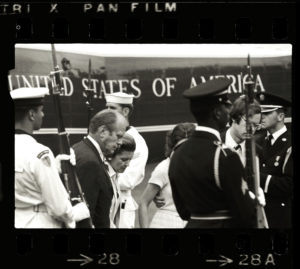Search Results for: nixon
My Thirteen Presidential Elections
This 2020 presidential election campaign is my thirteenth. I’ve covered them all since 1968, except for 1972 when I was in Vietnam photographing the war. (I have the best excuses.) Due to Covid-19, this year I only caught the early action in February, during the New Hampshire Primary. Thankfully it produced some telling images.
Campaigning for president is as American as apple pie, and photography has been a part of that process almost since it was invented. Abraham Lincoln was the first presidential candidate who really understood the power of photography, and said that Matthew Brady’s portrait of him, combined with his Cooper Union speech, made him president. The portrait, reproduced through woodcuts and engravings, was disseminated throughout the country, even though it would be another 20 years before the first photograph was published in 1880.
According to historic material about Lincoln in the Roosevelt House archive, one of his supporters noted, “I am coming to believe that likenesses broad cast, are excellent means of electioneering.” And an opponent complained, “the country is flooded with pictures of Lincoln, in all conceivable shapes and sizes, and cheap.”
Politicians like to stand above everyone else, and Teddy Roosevelt was one of them. A picture of him standing on a table talking to a crowd is a good example of that. He understood spin, and used publicity – often in the form of photographs -- to further his goals. Henry Stoddard, a journalist at the time said, “It’s true that TR liked the centre of the stage—loved in fact, but when he sought it he always had something to say or to do that made the stage the appropriate place for him.” Roosevelt’s legend, built on his championing the plight of the common man and his informal style, were re-enforced by photos of him at center stage.
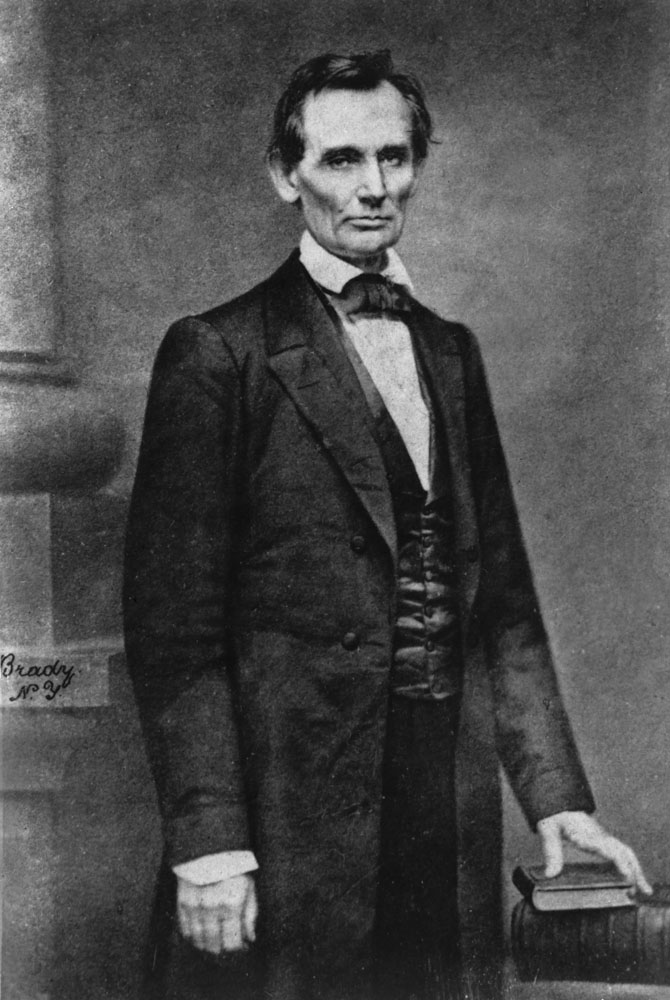


1968 By the time I came along, photography and campaigning for president went hand in hand. My first real presidential election-year photos were taken that year of Robert F. Kennedy as he ran for president. I was a 21-year-old wire service photographer assigned by UPI to cover him on a campaign trip through New Mexico and Arizona, and then in Los Angeles. My pictures of him in the predominately Black neighborhood of Watts in L.A. were very revealing about the kind of man that he was. Watts was the scene of major and lethal rioting in 1965, much of the area had been burned down, and 34 people were killed. That did not stop Kennedy from campaigning there, something that I thought was pretty brave for a white politician.
I was on the scene that horrible night at the Ambassador Hotel when he was gunned down. My last photo of him alive was when he raised his hand and made the “V” sign. Moments later, after he left the stage, he was shot. Two of my friends, Ron Bennett of UPI, and Bill Eppridge of LIFE documented the aftermath and made some incredibly dramatic photos. Those now historic pictures tell the story better than any words could.

Although I photographed Lyndon Johnson once after he left office, the first President I covered extensively was Richard Nixon. My first photos of him were right after he won the Republican nomination in Miami in 1968. He came out to California and was in Mission Bay in San Diego to plot campaign strategy. One of my photos caught a light moment between him and his running mate Spiro Agnew who would later resign as vice president. Nixon would go on to beat Vice President Hubert Humphrey and third party candidate George Wallace that year. It was fairly close in the Electoral College with 301 to Nixon, 191 for Humphrey, and 49 for Wallace.
1972 In Vietnam I followed the news from afar as Richard Nixon won re-election, beating Sen. George McGovern by 18 million votes, winning 49 states, (Massachusetts went for McGovern), and capturing 520 to 17 electoral votes. Apparently, I didn’t miss much drama.

1976 The real excitement began when I got back from Southeast Asia. I was there to see President Nixon wave goodbye on the South Lawn of the White House after he resigned on August 9, 1974, and the next day I became President Gerald Ford’s chief White House photographer. In that position I got the opportunity to see a White House and an election from the inside. Ford campaigned heavily against Georgia Governor Jimmy Carter in the last two weeks before the election, had two debates with him, and came very close to beating him. But Ford’s pardon of Nixon a month into his presidency had tanked him in the polls, putting him way behind at the outset of the election, and he just never caught up. The final tally was 297-240 in the Electoral College, and in the no consolation category, Ford won the majority of states 27-23. I personally felt bad about Ford’s loss because I thought he deserved it, and would have done a great job with a full four year term.

1980 This election pitted President Jimmy Carter against former California Governor Ronald Reagan. The popular Reagan had come close to beating President Ford in the 1976 primaries, but was edged out in a squeaker at the Republican Convention. I was back working for TIME Magazine, and they assigned me to photograph the Quixote-like independent campaign of John Anderson. In June he was polling at 25%, his high point, and he ended up only getting 6.6% of the final vote. Reagan beat the incumbent president in a landslide 472-59 in the Electoral College, and by 17% overall. It was the worst loss for an incumbent president since FDR shellacked Hoover in 1932.


1984 President Reagan beat former VP Walter Mondale in another landslide, winning 525 of the 538 electoral votes, the most of any presidential candidate in history. Mondale only carried his home state of Minnesota. I was at the Century Plaza Hotel in Los Angeles when the crowd chanted “Four more years!” Reagan smiled and said, “I think that’s just been arranged.”

1988 An election year where a photo a photo of a candidate doing something made the difference. Sorry I wasn’t there to take it! The picture showed Democratic nominee Mike Dukakis riding in an M1 Abrams tank wearing a helmet and waving. Not a good look. Vice President George Bush’s campaign made ads of it that mocked Dukakis. A picture that didn’t cause a problem for VP Bush was President Reagan campaigning for him in California at a rally that featured him holding up the arm, (leg?), of the famous San Diego Chicken. It must have helped. Bush won the Electoral College vote 426-111, carried 40 states, and racked up seven million more votes than his opponent.

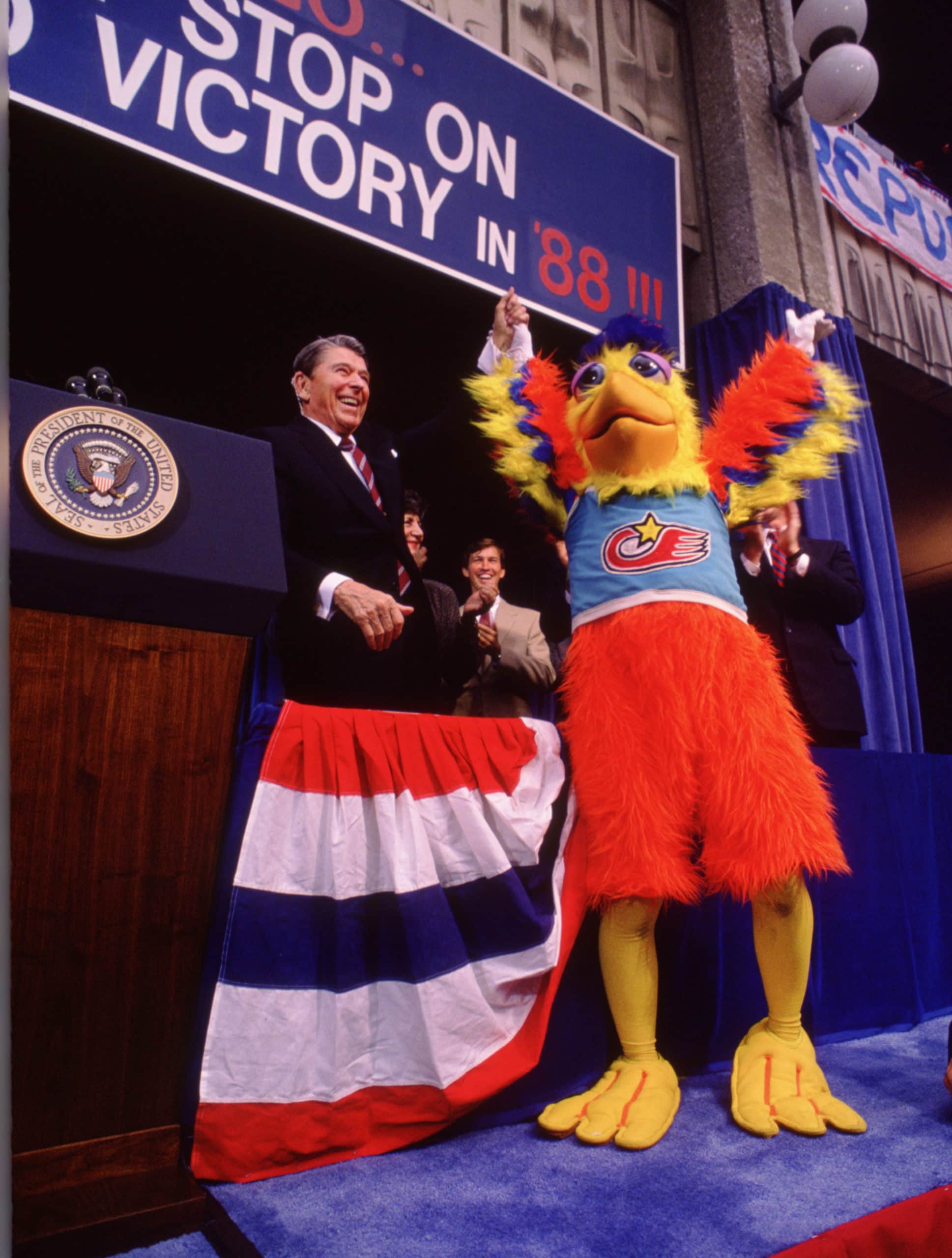


1992 President George Bush lost to the former governor of Arkansas Bill Clinton, and to make it worse, Clinton was young enough to be his son. I was with him on the final days of the campaign, and in Houston at the Westin Galleria when he conceded. It was a grim moment for the old warrior. President Bush's 37.5% was the lowest percentage total for a sitting president seeking re-election since William Howard Taft in 1912 who only got 23%. Clinton took the Electoral College 370-168.
1996 I got off on the wrong foot with Sen. Bob Dole who was running against the incumbent President Bill Clinton. I was shooting the campaign for Newsweek, and my first cover for them was a stark black and white portrait of Dole with the headline, “Doubts About Dole.” My name was also prominently displayed next to the photo, so there was no way he didn’t know who took it!
After it hit the newsstands I saw Dole for the first time in the lobby of the Holiday Inn in Manchester, New Hampshire. I was standing next to former U.N. Ambassador Jeane Kirkpatrick. Dole saw me, and made a beeline over. He didn’t look happy, and sarcastically said, “Really glad we let you spend all that time with us.” I said that I’d taken a lot of good pictures during that couple of weeks. He said, “That photo on the front of Newsweek made me look like I was dug up from the grave.” He then turned and abruptly left. Ambassador Kirkpatrick smiled sweetly and said, “well, it looks like you made a real friend there.”

The next time I saw Senator Dole he was sitting between Texas Gov. George W. Bush and former President George Bush in Houston. During the photo op Dole pointed at me, and said “Do you know Dave Kennerly?” They did. “He took that awful picture of me on the cover of Newsweek. It cost me five points in the polls.” Guess I hadn’t gotten back in his good graces. It’s worth pointing out that the words accompanying a photo could influence people’s judgment of the person. If the headline had been something like, “Bob Dole’s Presidential Quest,” instead of “Doubts About Dole,” he and others might well have viewed it differently. My job, however, isn’t to please or skewer. Dole went on to lose by almost nine points in the popular vote to Clinton, and Independent candidate Ross Perot picked up a little over 8%. Clinton got 379 Electoral votes to Dole’s 159. Perot zero.

2000 Newsweek gave me my choice of candidates to cover, either Gov. George W. Bush or Sen. John McCain for the turn of the millennium election. Figuring that Bush’s campaign would be restrictive to the press, and very conventional, I chose to follow the political maverick McCain, an ornery and colorful Vietnam War hero. (Note to Donald Trump: He was a hero not for being shot down and captured, but for rejecting the North Vietnamese’s offer for an early release ahead of others who had been POW’s longer. McCain was the first to tell you that getting blown out of the sky and being taken prisoner was by no means heroic.)

My travels with McCain were a photographer’s dream. Total access to him and his advisors, a permanent seat on his campaign bus, The Straight Talk Express, and a really interesting and honorable guy to photograph on top of it. I calculated that the odds were against McCain winning the Republican nomination for president, but if he was victorious it would be a political earthquake that would shake up the establishment. He almost pulled it off, and whupped Bush in the New Hampshire Primary by 18 points. The victory was short lived, Bush & Co. napalmed McCain in South Carolina, and derailed his momentum. McCain withdrew from the race on March 9 against the backdrop of Sedona, Arizona.

For a few weeks after McCain’s departure I covered the Democratic nominee Vice President Al Gore, and for the last couple of weeks of the campaign switched over to Bush’s running mate Dick Cheney. That move put me in the room at the governor’s mansion in Austin with his inner circle election night.
Gore had conceded to Bush before I arrived at his residence, and everyone was celebrating. Then came the shocker: Gore withdrew his concession in a private call to Bush. I heard about it firsthand before anyone else. I was in the kitchen getting a drink of water when Bush came down the back stairway from the family quarters. He had just talked to Gore and appeared shell shocked. Bush looked at me and said, “He took it back. He took it back.” I said, “Who took what back?” He said, “Gore. He took back his concession.” All I could think to say was, “Well that sucks.” He agreed. Gore took it back because Florida, the state that could put either of them over the top in the Electoral College became too close to call. That’s how the night ended.
It’s worth noting that Gov. Bush’s brother Jeb, the governor of Florida, was also in the room, making for even more drama. Ultimately the Supreme Court gave it to Bush a month later. If John McCain had been the candidate there wouldn’t have been a tie, in my estimation he would have picked up plenty of Democrat votes, and he would have beaten Gore straight up.
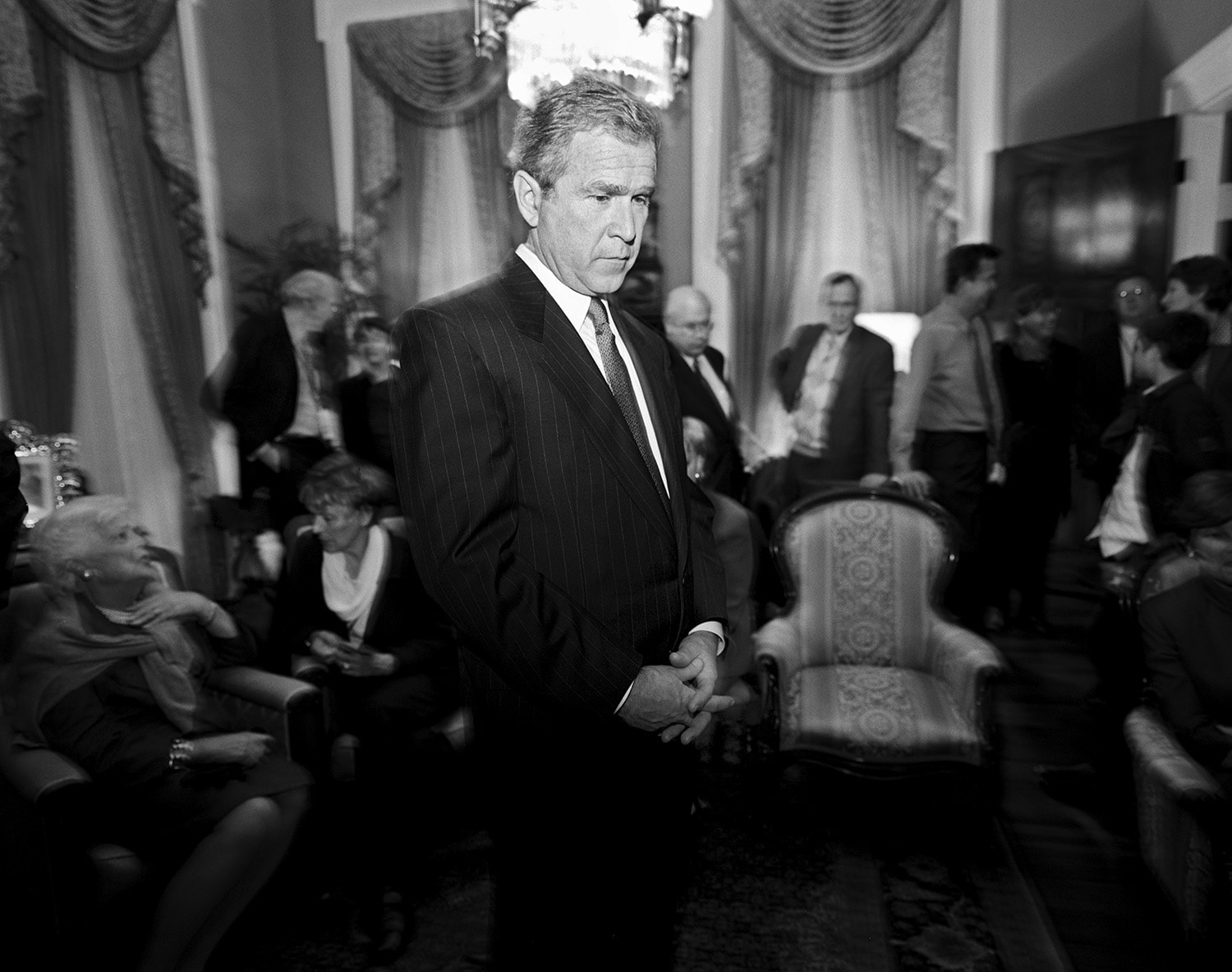
2004 If life had do-overs, Democratic presidential nominee John Kerry probably wouldn’t have gone windsurfing off Nantucket for the photographers. I was out on the boat when he did it, courtesy of his campaign, and was impressed with his athletic ability. At the time I wondered if it was a good idea for him, but hey, it was their call. It turned into a Dukakis-like moment. The GOP made ads featuring Kerry windsurfing and tacking back and forth in a ballet-like scene set to the Strauss waltz, “By the Beautiful Blue Danube.” The ad claimed that his positions shift, “whichever way the wind blows.” I thought it was pretty clever, but the Kerry folks, of course, branded it “tasteless.” They left out very funny. It was a close election, but Bush won 286-251 in the Electoral College, and 50.7% of the popular votes.

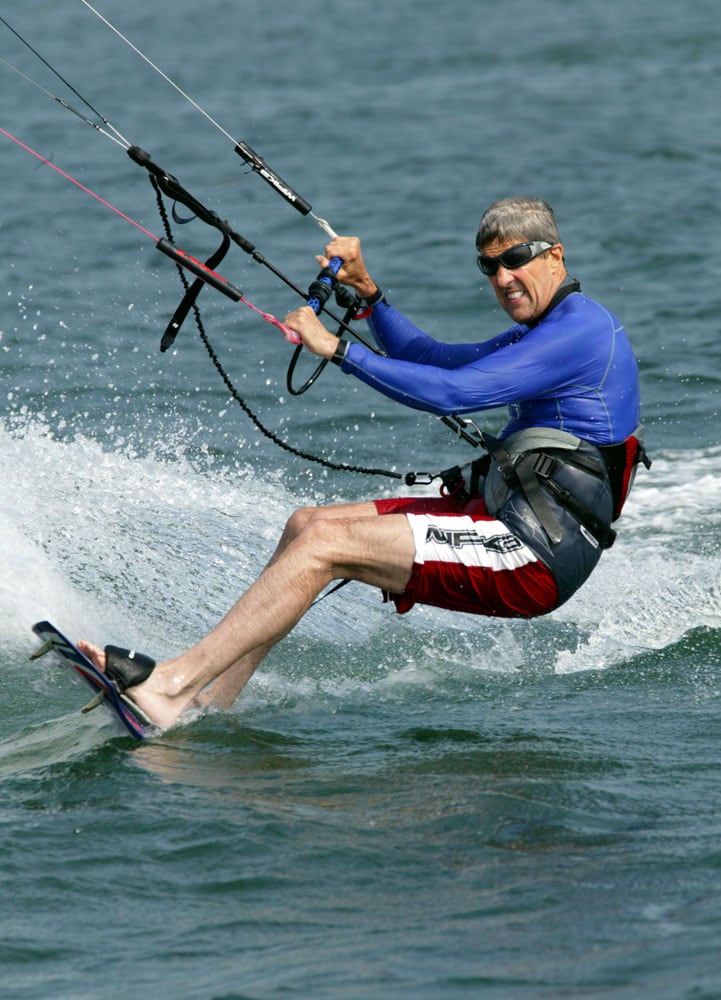
2008 John McCain was back in the saddle, and this time he got the Republican nomination. His opponent was fellow Senator Barack Obama. I spent a few days with him as he campaigned in New Hampshire. In a superstitious moment on that second New Hampshire Primary election night, McCain gathered all the same people who were there in the room eight years earlier when he kicked Bush’s ass. I was one of them. His victory in the Granite State was a moment that closely replicated his earlier triumph, even though he only edged out his competitor Mitt Romney by five points to win. In the general campaign McCain showed that he was more patriot than politician. During a town hall in Minnesota a woman said, “She couldn’t trust Obama. I have read about him . . . he’s an Arab.” McCain gently took the microphone from her, and shook his head. She said, “No?” McCain decisively told her, “No ma’am. He’s a decent family man, citizen, that I just happen to have disagreements with on fundamental issues.” He then looked up to the crowd and told them. “That’s what this campaign is all about.” Obama impressively won the election 365 to 173 in the Electoral College, and took almost 53% of the popular vote, becoming the first African-American president of the United States.
John McCain might have lost, but he left the stage with his honor firmly intact.

2012 I was with Republican presidential candidate Mitt Romney on his campaign bus in Virginia the day that he announced Rep. Paul Ryan as his running mate. Romney was in a pensive mood, and I took a good photo of him alone thinking about the upcoming campaign. I had looked up his birthday, and discovered that we were born three days apart, mine was March 9, 1947, his March 12. I told him this, but I said there was one big difference between us. “What’s that?” he said. “You’re a tribute to clean living, and I’m not,” I jokingly told him. He thought that was funny. I also discovered we liked a lot of the same kind of music, and the Kingston Trio was right at the top of both of our lists. That fact will not stir any excitement among my three sons! Romney did a bit better than McCain, but not much. The Electoral College tally was 332-206, and President Obama got 51% of the popular vote.


2016 This was the election that was supposed to see the first woman in America’s history elected president. I was asked by CNN to cover the campaign for them. I photographed the Republican Convention in Cleveland where Donald Trump was nominated, then drove to Philadelphia for the Democratic gathering. I decided to take some of the back roads through Pennsylvania and was shocked by how many pro Trump displays there were in formerly Democratic areas. There were Hillary Clinton posters out there also, but most of them said, “Lock Her Up!” Not an auspicious sign for HRC’s campaign.
Later in the fall I spent five days on the Clinton campaign. When I talked to her briefly at St. Anslem College in New Hampshire, she told me, “I wish the election was tomorrow.” She would have won if that had been the case, but unfortunately for her there was an October surprise four days later when FBI Director James Comey reopening an investigation into her emails. The election was eleven days away, and disaster loomed.
The last ten days of the campaign I spent covering Donald Trump, and it was clear he had a lot of support. People would wait in line for hours to get into his rallies. In the last ten days of the campaigned Trump blitzed twelve states with stops in Arizona, Florida, New Hampshire, Pennsylvania, Colorado, Nevada, North Carolina, Virginia, Michigan, Iowa, Minnesota, and Wisconsin. The campaign ended in New York City for both campaigns, the Clintons at the huge Javits Convention Center, and Trump’s in the much smaller Hilton Hotel ballroom.
Trump appeared with his family after being declared the winner. It was unlike any victory celebration I have ever witnessed. The president-elect barely broke a smile, and if you had been watching television with the sound off, you would have thought he was the one who lost. He hadn’t. Just down the street at the Javits Center, Hillary Clinton didn’t make an appearance. Her political career was finished.


2020 This election year has become the Covid-19 campaign. I was supposed to cover this one for CNN also, but everything changed after the coronavirus hit. Before everything got turned upside-down, I was able to photograph the New Hampshire Primary, my favorite political event of every four-year campaign cycle.
I attended a Trump rally in Manchester that was a carbon copy of the 2016 campaign, and still featured Trump haranguing the press. This time he added “fake news” to the dialogue not elevating his rhetoric in four years. The best photo was a “Daddy Dearest” moment of him kissing Ivanka in front of the crowd. The teleprompter bisects the two, but you get the point.

I was most impressed by my stop at a Joe Biden town hall meeting in Hampton Beach. It was a small gathering, maybe a couple hundred people, but it gave me a chance to observe the former vice president at his best. There was a particularly poignant moment when he talked about his son Beau who had died of brain cancer five years earlier.
The beauty of photography is that allows you, when the circumstances are right, to see behind the façade of someone, and to capture who they really are. This was one of those instants. The pain was there, the deep feelings were evident, and it wasn’t an act. There was one other powerful moment when Biden mingled with the crowd that struck me. A woman sought him out to share her grief about the loss of a loved one. He listened, empathized, and comforted her. You feel the emotion in the photograph.

Joe Biden will be the next President of the United States. Among his additional duties, and a role that has been AWOL for the last four years, will be an additional responsibility: Consoler-in-Chief. The country needs, and will get that.

Joe Biden will be the next President of the United States. Among his additional duties, and a role that has been AWOL for the last four years, will be an additional responsibility: Consoler-in-Chief. The country needs, and will get that.
40 Year Anniversary of Nixon Resignation
In the Room When Ford Pardoned Nixon
The following post contains several unpublished photos that I took of President Ford before, during, and after the pardon of Richard Nixon forty years ago today.
Sunday, September 8, 1974 started off in a fairly routine fashion for President Gerald R. Ford. He attended St. John's church just across Lafayette Square from the White House, then returned to the White House. What happened after that insured that he would not get a term in his own right as President of the United States. He pardoned Richard Nixon.
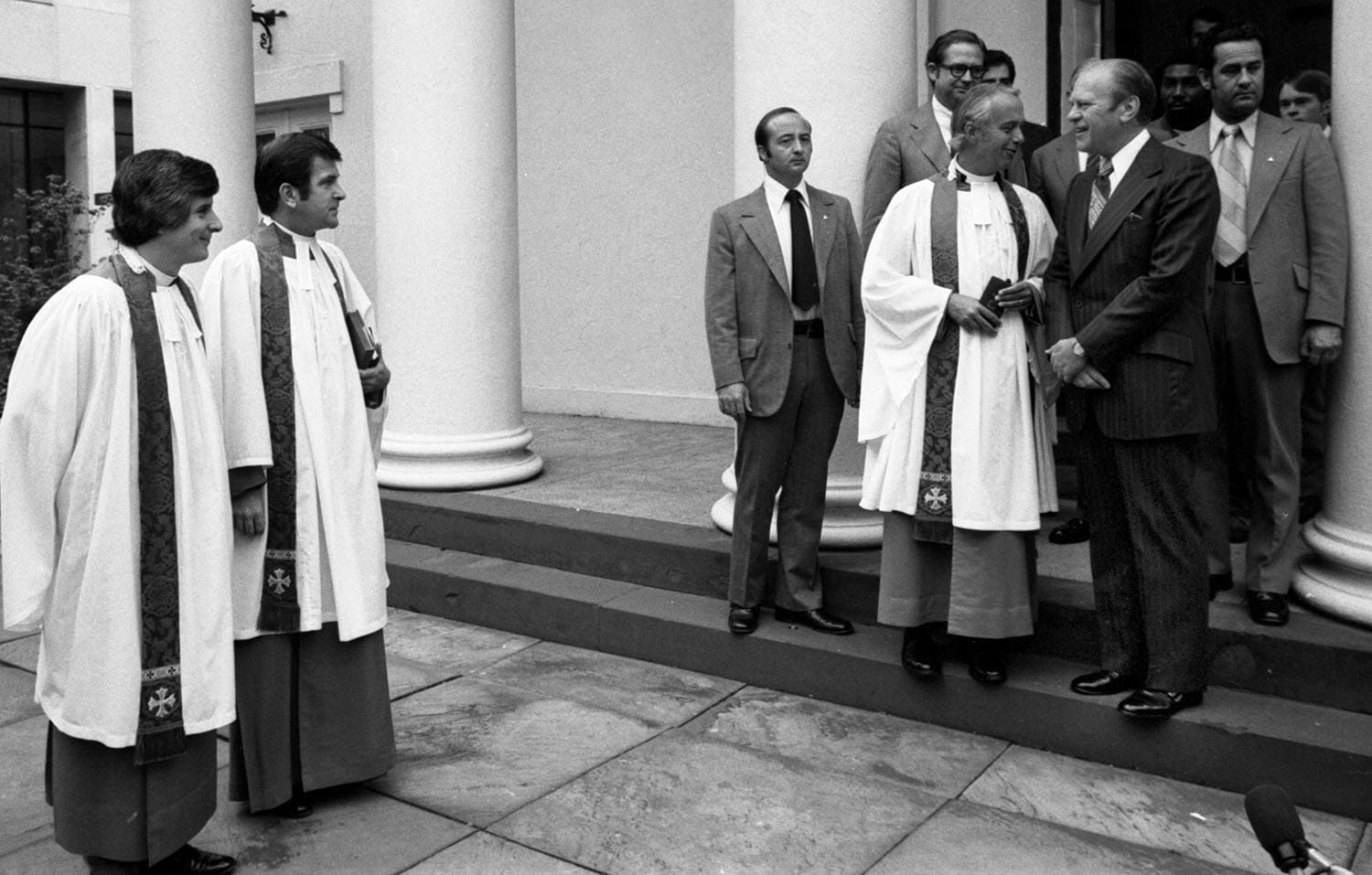
President Ford leaves St. John's church on his way back to the White House to sign the Nixon pardon.
Before he publicly announced the pardon President Ford made a series of telephone calls to inform the leaders of the House and Senate what he was going to do. He phoned, (in this order), Senate Majority Leader Mike Mansfield, Speaker of the House Carl Albert, Senate Minority Leader Hugh Scott, House Majority Leader Tip O'Neill, Attorney General William Saxbe, House Majority Whip John McFall, Vice President-designate Nelson Rockefeller, and Senator Barry Goldwater.
Head speechwriter Robert Hartmann and I were the only ones with President Ford in his private hideaway next to the oval office as he prepared to make the fateful announcement. The president sat by himself and looked over the proclamation. He didn't say anything to either of us. The decision was made, he was ready, and moments later he stood up, a look of resolution on his face, and said, "Let's go."

President Ford looks over Nixon pardon document in his private office before publicly signing it a few minutes later

President Ford with speechwriter Robert Hartmann seconds before entering the oval office to sign the pardon of former President Nixon
At 11:16 am in the oval office, President Ford reads the announcement before signing the pardon. At the end of his talk he said,
". . . I, GERALD R. FORD, President of the United States, pursuant to the pardon power conferred upon me by Article II, Section 2, of the Constitution, have granted and by these presents do grant a full, free, and absolute pardon unto Richard Nixon for all offenses against the United States which he, Richard Nixon, has committed or may have committed or taken part in during the period from January 20, 1969 through August 9, 1974.
IN WITNESS WHEREOF, I have hereunto set my hand this eighth day of September, in the year of our Lord nineteen hundred and seventy-four, and of the Independence of the United States of America the one hundred and ninety-ninth."

Sitting behind his desk in the oval office, President Gerald R. Ford prepares to read the text of the Nixon pardon

President Ford reads the text of the pardon in front of a lone television camera on Sunday morning, September 8, 1974.

Phil Buchen, President Ford's chief legal counselor and old law partner from Grand Rapids, watches the proceedings.

President Ford signs the paper pardoning former President Richard Nixon
(Yes, I shot this one in color...)
Moments after signing the pardon, President Ford walked down the hallway to the office of Bill Timmons who was head of legislative affairs. Timmons was there fielding calls from members of Congress about the pardon, along with Ford's (and Nixon's) chief of staff Alexander Haig, White House counselor Jack Marsh, and Hartmann. What I found shocking was that almost everyone who called in that morning privately told the president that he had done the right thing, but publicly went out and lambasted him. At that point I had quite a bit to learn about real politics. As usual President Ford took it all in stride, but definitely felt the pressure.

President Ford gets reaction from Congress in the office of his legislative affairs assistant. (L-R) Robert Hartmann, Bill Timmons, the President, Al Haig, Jack Marsh.

Photographing ironic moments is my strong suit, and this photo of President Ford under a picture of himself as vice president and Nixon as president minutes after the pardon is right up there in the heavy irony category.
(L-R) Bob Hartmann, Al Haig, Bill Timmons, the president, and Jack Marsh.
President Ford's approval rating plummeted from 71 to 37 after the Nixon pardon, and he wasn't able to politically recover in order to win a term in his own right. There was a lot of piling on among his fellow pols. Sen. Teddy Kennedy in a speech in Los Angeles after the pardon said, "So we operate under a system of equal justice under the law? Or is there one system for the average citizen, and another for the high and mighty." Ouch. Unfortunately that pretty well reflected what the majority of Americans thought at the time, and Ford's popularity was in the cellar.
By 2001 Senator Kennedy had changed his tune, and along with Caroline Kennedy presented President Ford with the JFK Profile in Courage Award.”‹ The award was created in 1989 by members of President Kennedy's family to honor the fallen president and to recognize and celebrate the quality of political courage that he admired most. "For the scientist, the moment is the Nobel or the Lasker; for the journalist, the Pulitzer; the actor, the Oscar. For those in government, it is the Kennedy." Governor Lowell Weicker
Sen. Kennedy said, "Unlike many of us at the time, President Ford recognized that the nation had to move forward, and could not do so if there was a continuing effort to prosecute former President Nixon. His courage and dedication to our country made it possible for us to begin the process of healing and put the tragedy of Watergate behind us."
Caroline Kennedy, now the ambassador to Japan, while presenting the award to President Ford said, "For more than a quarter century, Gerald Ford proved to the people of Michigan, the Congress, and our nation that politics can be a noble profession. As President, he made a controversial decision of conscience to pardon former president Nixon and end the national trauma of Watergate. In doing so, he placed his love of country ahead of his own political future."
President Ford told me later that the Profile in Courage Award was one of the most important things that ever happened to him. He was very emotional when he talked about it, and a tear ran down his cheek as he recounted the experience.
”‹
Forty Years Ago Today–Nixon’s Farewell
Column 1

Nixon looks at White House for last time as president before boarding helicopter.
Column 2

Nixon departs after resigning, contact sheet
Nixon resigning, and leaving the White House forty years ago today, was one of the top five stories that I've covered in my career as a photographer. The others, in no particular order, are Vietnam, Jonestown, Sadat's trip to Israel, and the Reagan/Gorbachev Summit in Geneva. There have been plenty of others!
When I revisited this sequence of photos of Nixon on the steps of Army One, the presidential helicopter, I had always keyed on fame #12 as "the moment." A grim Nixon, lips pursed, arm bent as he gave a sharp wave goodbye, was leaving The White House in disgrace. It was a frame that I had always thought said it all. But not really. Forty years later, and after much consideration, I think the most telling photo is frame #11, where Nixon, having just started up the steps, turns and looks back at a scene he will never see again as president--the South Portico of the White House looming before him. His face reflected that split second of pain, humiliation, and loss. He then gave a curt wave. Moments later, and you had to be there to see and hear the rest of what prompted his actions, the crowd who had gathered on the lawn to see him off, comprised mainly of loyal White House staffers, started cheering and applauding. Nixon reacted in the manner of the old campaigner, with arms waving, and fingers outstretched with the "V" for victory sign. A smile lit up his face. But it wasn't a campaign event, but it was the last stop of the Nixon presidency. That smile soon disappeared, along with the 37th president, who lifted off from the South Lawn as Gerald R. Ford, the next president, watched from below the South Portico..
”‹

Vice President Gerald R. Ford, with wife Betty and David and Julie Eisenhower, watch President Nixon depart after resigning. A few minutes later, at high noon, Ford became the 38th President of the United States.
16 Frames


16 Frames
My job is to be there when history is made. August 9, 1974 was one of the biggest days, an historic twofer -- one president quit, and another was sworn in to replace him.
I was on the South Lawn of the White House crowded onto a photo stand with the rest of the press corps when President Richard Nixon, accompanied by his wife Patricia, and Vice President and Mrs. Gerald R. Ford, walked out of the White House to the white-topped presidential helicopter that would carry him away into political exile.
The night before that fateful Friday, President Nixon went on television to announce that he was going to resign over the events of Watergate. Had he not decided to leave voluntarily he would have been impeached in the House and then convicted and removed from office by the Senate for his transgressions. He was the first and only president to resign. Even though we are now 46 years past that event, I still feel the shock from the moment. When I think about it, the event plays before me in slow motion.
There are sixteen frames that I made of Nixon climbing up the six steps of Army One until he ducked inside. At the time I thought the best image of that sequence was the second one, frame 12, where he gave a snappy wave, arm at a 45-degree angle over his head, and lips pursed. It definitely was dramatic, serious, and carried the weight of the moment.
History is a process of steeping. Sometimes the true flavor of a moment doesn’t emerge quickly. In this case it took more than 45 years. I recently came to the conclusion that the frame before the wave, No. 11, carries the most impact. Nixon’s look, captured in 1/500th of a second, as he glanced up at the South Portico of the White House for the last time, caught his flash of bitter realization. The game was over, he had lost, and would never see the place again as President of the United States. I can’t imagine the pain he must have been feeling at the moment, and even though it appears he’s trying to mask the feeling, it is palpable.

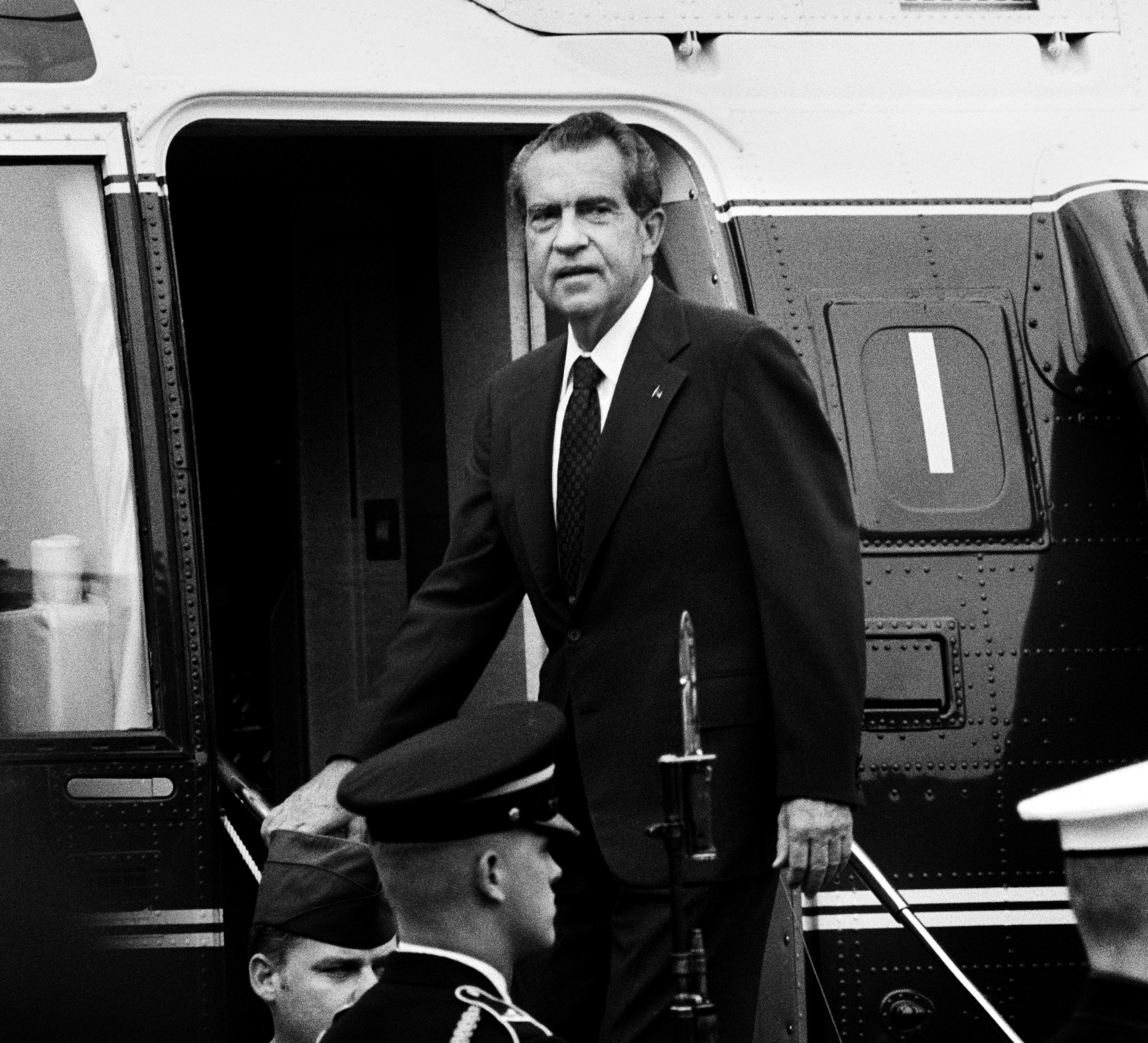
In the remainder of those 16 frames, what happened after that ricochet reflection was the hard tack back to reality. The grim wave expanded into a double “V” campaign-like moment that attempted to reclaim the glory days. His upbeat gesture was spurred by the White House staff who gathered on the South Lawn to see their disgraced leader off. They cheered him. But it wasn’t a campaign rally, rather it was one of the darker days in presidential history.
In less than 12 seconds from start to finish it was over. Sixteen frames, numbers 11 to 26, duly recorded for posterity. Frame 26 shows him ducking to enter the helicopter.
The next two photos, frames 27 and 28 show Vice President Gerald R. Ford, the man who would shortly become president, and Mrs. Ford, give Nixon one last wave goodbye through the window. They then turn and solemnly walk away.

Later that evening the new president would offer me the position as his chief White House photographer. Because my job is about history, and documenting those who make it, I took him up on it!
05_dhk_Nixon_Ford_p
Archive Deck 8
HISTORY CAPTURED - HIGHLIGHTS

1960s
OREGON JOURNAL, UPI First published photo in 1962 in the Roseburg High School “Orange R” school newspaper. The Pendleton Roundup; Tyghe Valley Indian Rodeo; Tigard shootout; The Supremes; Miles Davis in Portland; The Rolling Stones in Portland on their first U.S. tour; Lew Alcindor (Kareem Abdul-Jabbar) playing during his first year at UCLA; USC star O.J. Simpson after winning the Heisman Trophy; Igor Stravinsky; police with guns drawn at San Francisco State College; anti-war demonstrations, escaped prisoner from San Quentin gunned down by police; 1968 U.S. presidential campaign candidates Richard Nixon, Hubert Humphrey, Gene McCarthy; Ambassador Hotel the night Sen. Robert Kennedy was assassinated; Congressman Adam Clayton Powell’s anti-war speech; Hugh Hefner surrounded by Playmates; pitchers Denny McLain and Bob Gibson during their 1968 Cy Young-winning seasons; U.S. Open tennis championships at Forest Hills; Eisenhower’s funeral; Mickey Mantle Day; Mets winning the ’69 World Series; construction of the World Trade Center.

1970s
TIME, LIFE, CHIEF WHITE HOUSE PHOTOGRAPHER President Nixon made Kennerly a martini at the White House on Christmas Eve 1970. First ride on Air Force One at 23. Ringside at Ali-Frazier fight, Madison Square Garden. Vietnam for UPI; war between India and Pakistan; 1972 Pulitzer Prize in Journalism for Feature Photography; one of first Americans to enter PRC; release of the last American POWs in Hanoi; resignation of Richard Nixon; Gerald R. Ford’s Chief White House photographer; special mission to Vietnam and Cambodia right before those countries fell to the Communists; Kissinger’s last Mideast shuttle; in the room as President Ford ended US involvement in Vietnam; 1976 presidential campaign; Sadat’s historic trip to Israel for TIME; Camp David Summit; Northern Ireland hostilities; Osiris nuclear reactor being built outside of Baghdad that was later blown up by the Israelis; Havana for Fidel Castro; Jonestown mass murder and suicides; Exhibition at the Lunn Gallery in Washington, attended by Ansel Adams and Yousef Karsh.

1980s
TIME, FREELANCE War in El Salvador; 1980 presidential election; Reagan White House for TIME; Kennerly’s autobiography Shooter published; return of American Iran hostages to U.S.; Sandra Day O’Conner sworn in as first female justice of the Supreme Court; Morocco’s war with Polisario; U.S. Marines in Beirut; on patrol with PFLP fighters in hills above Beirut; funeral of assassinated politician Benigno “Ninoy” Aquino in Manila; 1984 Olympics; America’s Cup in Australia; 1984 presidential election; exclusive coverage of Reagan/Gorbachev “Fireside Summit” in Geneva; A Day in the Life of America; won Overseas Press Club Award for Reagan/Gorbachev coverage; A Day in the Life of the Soviet Union; with Pope John Paul II on his plane to Italy; 1988 presidential election; Emmy nomination for NBC movie, The Taking of Flight 847: The Uli Derickson Story, writer/exec producer of NBC movie Shooter starring Helen Hunt (Emmy winner for Best Cinematography); Tienanmen Square and the Forbidden City for A Day in the Life of China.

1990s
LIFE, FREELANCE, NEWSWEEK, GEORGE MAGAZINE, ABC Defense Secretary Dick Cheney and Chairman of Joint Chiefs Colin Powell in Saudi Arabia in prelude to Desert Storm; five presidents at Reagan Library; 1992 presidential campaign; the Oval Office as it transitions from Bush to Clinton; Nixon’s funeral; 1994 Olympics in Norway; book Photo Op published; exhibition of work at the Portland Art Museum in Oregon and Cannon House Office Building Rotunda at the U.S. Capitol; 1996 presidential campaign; Bill Clinton presidential coverage; Pyongyang, North Korea; Sen. John Glenn’s preparation for space shuttle flight as the oldest astronaut; the launch of SDS-95; Pope John Paul II’s trip to Cuba; Clinton impeachment story; the last two Seinfeld episodes exclusive for Newsweek; Seinoff: The Final Days of Seinfeld published; Clinton’s Senate trial; King Hussein funeral in Jordan; Kosovo war; inside coverage at NATO HQ with Supreme Commander General Wesley Clark; Macedonia; French aircraft carrier in Mediterranean; Northridge earthquake; People’s Republic of China’s 50th Anniversary Celebration.
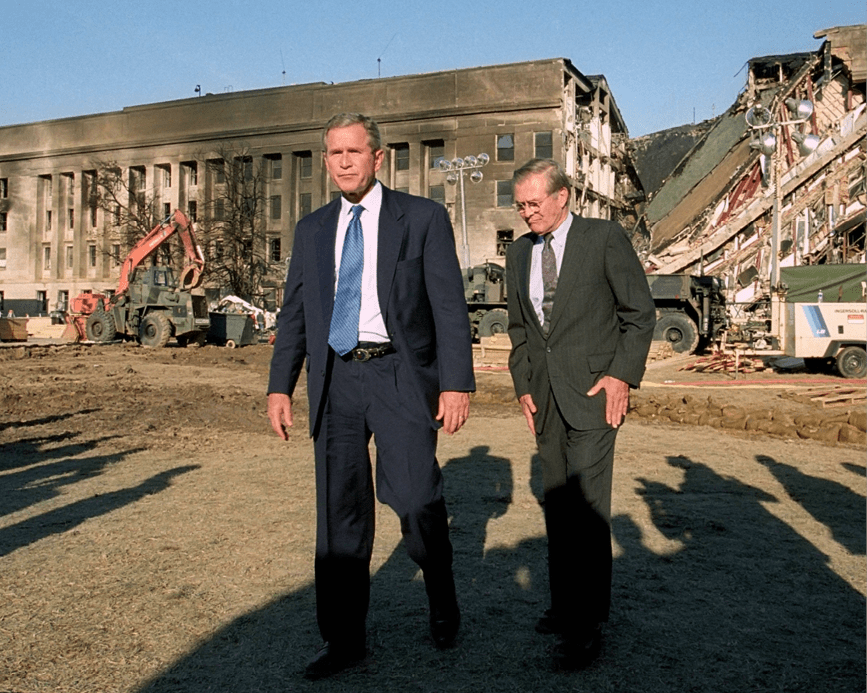
2000s
NEWSWEEK, DER SPEIGEL, PARIS MATCH, NBC 2000 presidential campaign; inside photos at governor’s mansion election night in Austin with the Bushes; Picture-a-Day in the year 2000 project; retrospective show at Visa Pour l’Image, Perpignan, France; Slovenia Summit with Presidents Bush and Putin; 9/11 attack on Pentagon; to Afghanistan to photograph that conflict; exec producer of ABC’s Profiles from the Front Lines about U.S. Special Forces in Afghanistan; Photo du Jour published; exhibition of Photo du Jour at the Smithsonian Arts & Industry Building; inside the Pentagon at the start of the Iraq War; secret trip to Iraq with Secretary of Defense; 2004 presidential campaign; Rumsfeld’s trip to Abu Ghraib; named “one of the one hundred most important people in photography,” by American Photo Magazine; Extraordinary Circumstances: The Presidency of Gerald R. Ford published; 2008 presidential campaign; becomes trustee of the Gerald R. Ford Foundation; producer, chief photographer, Barack Obama: The Official Inaugural Book; five Presidents Obama.

2010s
FREELANCE, DER SPIEGEL, POLITICO, CNN Ramadi and Karbala in Iraq; Iceland, Costa Rica and France for Backroads; Girl Scouts photos appear on millions of cookie boxes; New Orleans for post Katrina coverage; featured speaker at the Aspen Ideas Festival; 2012 presidential campaign; Mitt Romney and his running mate Paul Ryan; Betty Ford funeral; Haiti, Northern Ireland, London, India, Singapore, Indonesia, Poland, South Africa, Swaziland, Japan, for Vital Voices; TEDxBend speaker; producer, Discovery Channel’s The Presidents’ Gatekeepers about White House chiefs of staff; President Obama’s second Inauguration; David Hume Kennerly on the iPhone published; King Abdullah II meeting with President Obama; commencement address and honorary doctorate, Lake Erie College; executive producer, CBS/Showtime documentary The Spymasters: CIA in the Crosshairs; featured speaker at the annual Bank of America board meeting; recipient of 2015 Lucie Award for Achievement in Photojournalism, presented at Carnegie Hall; 2016 presidential campaign; Bernie v. Hillary CNN Debate, Brooklyn.
On this day 42 years ago… August 9th
I remember August 9, 1974 less as the day President Richard Nixon left the presidency, but as the day Gerald R. Ford assumed it.
The morning started on the South Lawn of the White House where I was assigned by TIME Magazine to photograph one of the most dramatic events in U.S. history. This was the first time any U.S. president had resigned, and the national was reeling. From the moment Nixon stepped onto the first step of his helicopter, glanced up for the last time at the Truman Balcony, waved his arms with the familiar “V” sign, then disappeared inside Marine One, only ten seconds had elapsed. I caught every one of them. As the film ratcheted through my camera I only had one thought on my mind, “I can’t believe what I’m seeing, and I don’t want to miss a moment of the spectacle.” I didn’t. In fact with my motor drive cranking I freeze-framed 17 exposures of the historic scene.

As Nixon’s helicopter lifted off I trained my lens on Vice President and Mrs. Ford. They stood next to David and Julie Eisenhower, Nixon’s daughter and son-in- law as they watched him recede into the distance. A White House butler completed the tableau.

A short time later, at high noon in the East Room of the White House, Gerald R. Ford was sworn as the 38 th President of the United States by the Chief Justice of the Supreme Court. President Ford then declared our long national nightmare over. I caught that moment. He looked not only grim, but also resolved to deal with what lay ahead.
That evening I was invited to the Ford’s modest home in Alexandria. After the other guests left the president wanted to talk to me about becoming his chief White House photographer. The next day I became the third civilian to ever have that job.
Kennerly Commencement Address at U of Arizona
David Hume Kennerly’s address to the Commencement and SBS Convocation, 2021 graduating class of the School of Social Sciences & Behavioral Sciences, “The People College” at the University of Arizona, Tucson, December 17, 2021
What an amazing group!
Congratulations to the graduating Class of 2021. You have survived and triumphed over our ongoing Covid nightmare, and from the looks of it have not only emerged intact, but raring to get on to the next step.
I wouldn’t be standing here today if it wasn’t for University of Arizona president Dr. Robert Robbins the driving force behind the university’s acquisition of my archive for the Center for Creative Photography, the CCP. I’m assuming that also makes me an official Wildcat, but I don’t want to be presumptuous. Your most excellent leader Dean John Paul Jones III has become a dear friend and invited me to speak today. Depending on how this goes you may or may not want to thank him.
It’s a real pleasure to speak to you. I’ve had my fair share of significant moments, but none of them include a college graduation, so each of you has already surpassed my academic achievements!
My dear friend Ansel Adams was co-founder of the CCP, I hope you know that his archive is right here on campus. I was privileged to take his portrait for the cover of TIME.

He is the first and only photographer to be featured there. Ansel was also a philosopher. He said, “You don’t make a photograph just with a camera. You bring to the act of photography all the pictures you have seen, the books you have read, the music you have heard, and the people you have loved.”
I thought I would share this with you because Ansel’s words apply not only to photography, but to life.
After graduating from high school in 1965 the world was changing in ways I couldn’t imagine.

I felt compelled to tell my generation’s story with my weapon of choice--a 35mm camera. That desire to document turned into a life-long journey that has (so far) produced hundreds of thousands of photos. I’ve photographed 11 presidents, traveled to more than 100 countries, been in several wars, saw the horror of Jonestown, and have produced movies and documentaries.

I’d like to pass along some wisdom from my dad, O.A. “Tunney” Kennerly who was a traveling salesman.
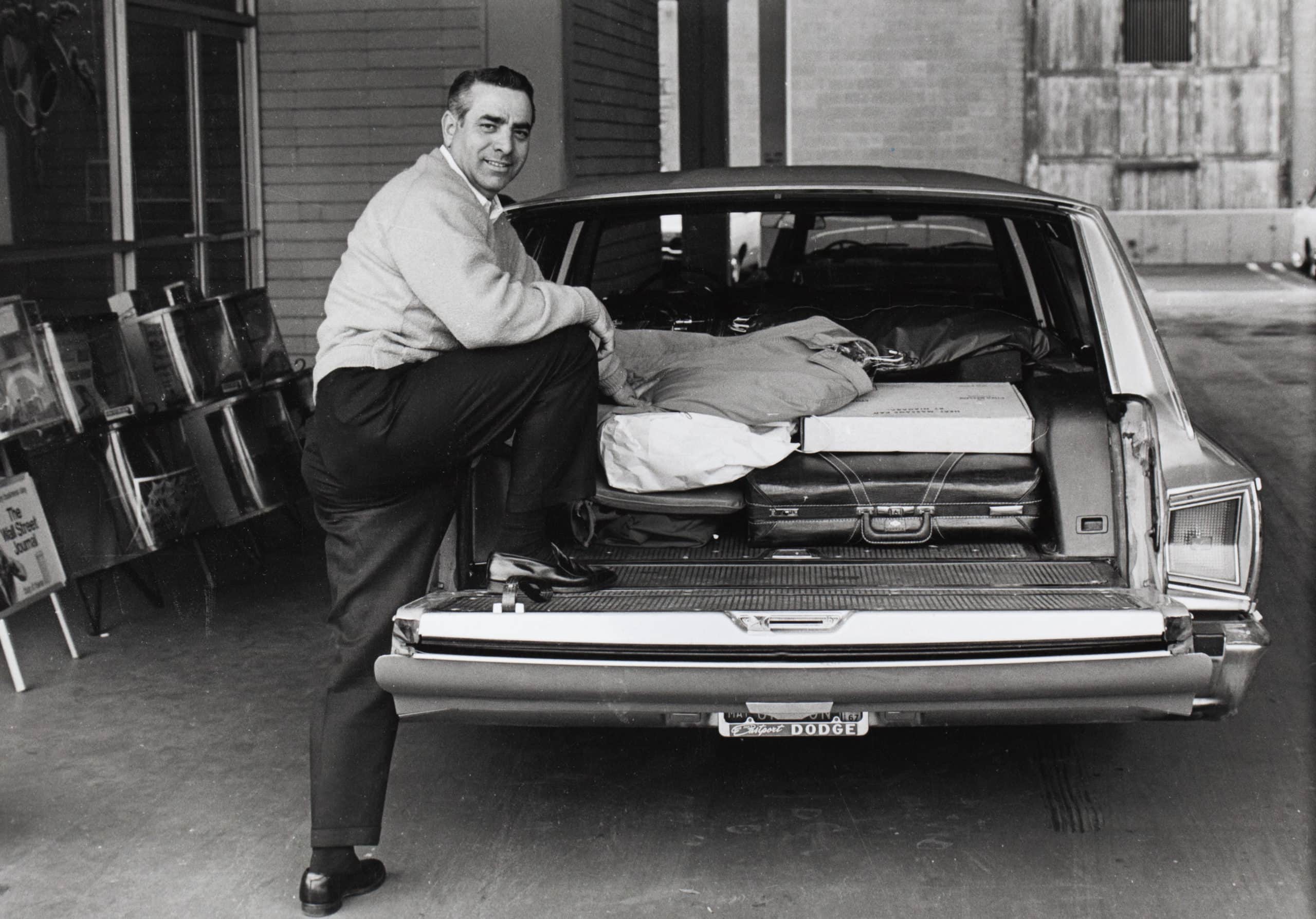
During his life he sold everything from plastic garden tools to automobiles. As a youngster I accompanied him around my home state of Oregon watching him sell people things they didn’t really need, or at least didn’t know they needed! One bit of advice he shared with me was, “If you want to get along with people don’t discuss politics or religion.” That advice might be more pertinent now than ever.
Observing Dad in action helped me understand his real secret. He was selling himself first. He put people at ease and made them laugh. Tunney was a genuine individual who liked his fellow humans and they liked him back. And bought his stuff.
His example helped me get behind closed doors with my camera.

I became very good at convincing (selling) politicians and others on the idea of letting me into their lives to document their important work and to photograph them in genuine moments.
One of my earliest assignments as a 19-year-old cub newspaper photographer was covering Sen. Robert Kennedy’s visit to Portland. I set off on that mission with words from the managing editor ringing in my ears, “Don’t screw it up, kid.”

I arrived at the Portland Labor Hall where Kennedy was going to speak. It was so crowded I couldn’t get in. But I had to or possibly lose my job. I spotted a photographer who was travelling with Kennedy. I asked him, ‘How do you get through all these people?’
He was Bill Eppridge of LIFE Magazine, one of the world’s best. Sensing my panic he said, “Grab onto my coat.” He zigzagged through the crowd and deposited me right up on the stage. He added, “This is the best angle.”
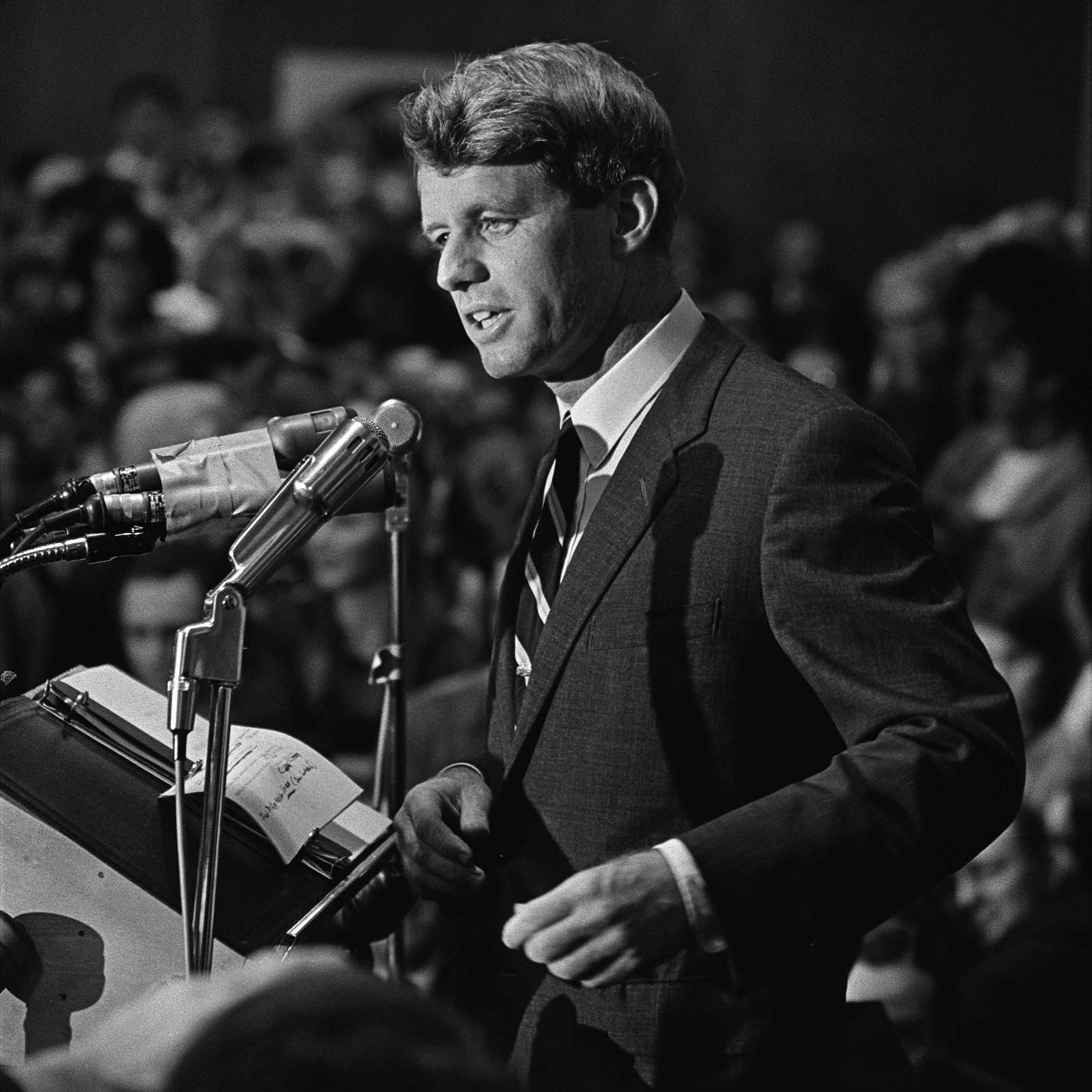
It was also a career saver! This image that I made of Kennedy is still one of my most meaningful pictures.
Afterwards I followed the senator and his entourage out to the airport. RFK plunged into the cheering crowd then he dashed up the airplane’s steps.
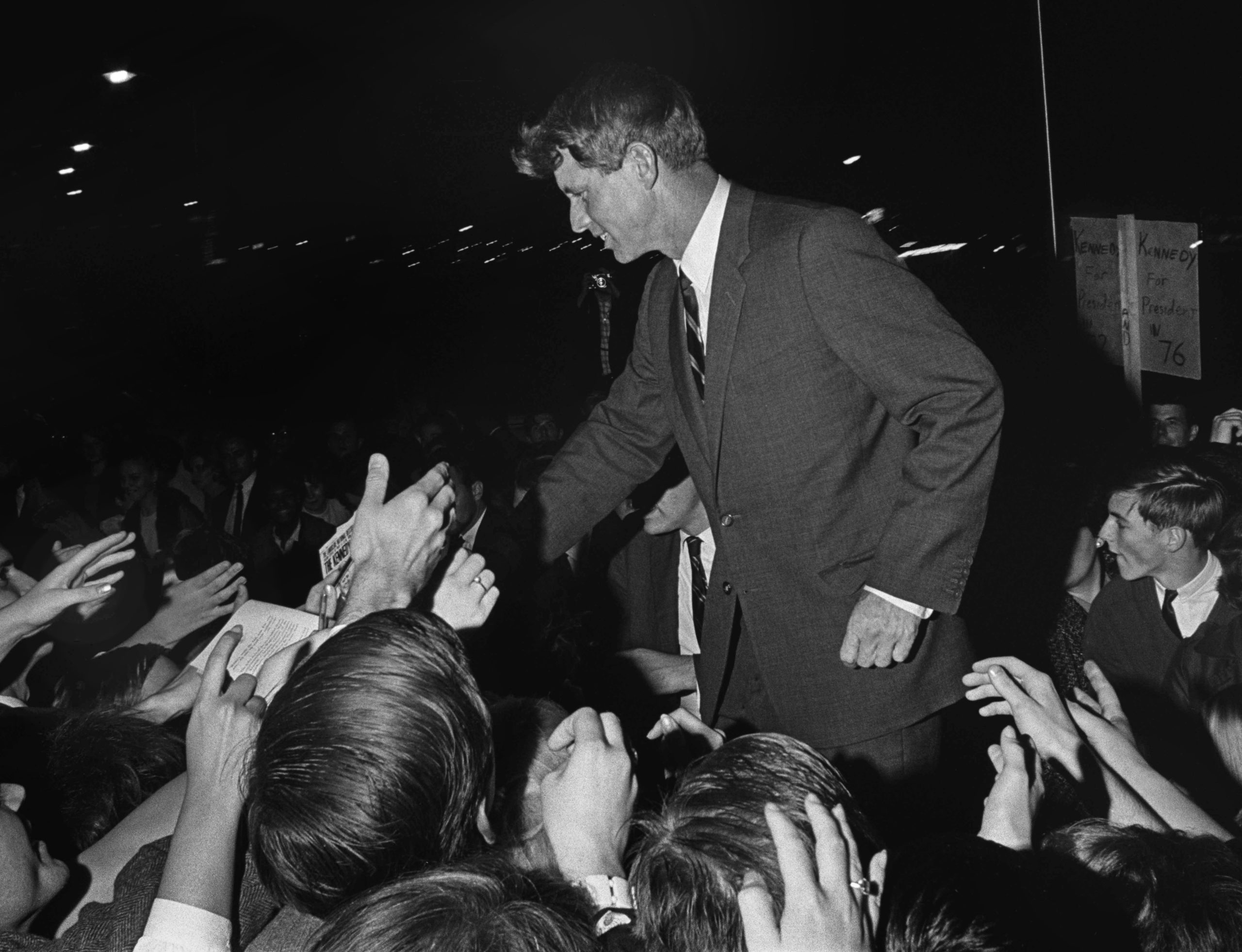
But that’s not what rang my bell. THE moment, the one that’s so clear to me even now, was when Bill Eppridge followed Kennedy, stood on the top of the plane’s stairs then spotted me in the crowd. He flashed me a wink and a smile then turned and disappeared inside the plane. The door closed behind him, and the aircraft taxied out and took off into the night.
I was overwhelmed with emotion. Why? I wanted to be on that plane, to go where history was being made and to photograph the people making it. My path was suddenly clear. I would run away and join the political circus. (Full circle note: I was right here on campus with him in 1968 when he made a campaign stop).
We’re all here because someone pointed us in the right direction. Somebody cleared away obstacles--or let us hang onto their coat. You haven’t had to walk alone. With luck you’ll run into compassionate and inspiring people like Bill Eppridge who will bless you with their drive, expertise, and most of all kindness.

A few months before Bill died I was able to thank him for helping me find my way. It’s hard to express how important that was for me.
As I was coming up through the ranks of photographers I had no idea what decades of my pictures might reveal. I never thought I would make it this far, and there were so many times when I almost didn’t. Overcoming fear to do my job was essential, but trust me, it didn’t make me less scared on occasion!

Getting the shot and telling the story is what drives me. An example is a picture that I took in Vietnam of a lone soldier carefully picking his way across a devastated hillside.

I saw him coming from across the way and moved to position where I could frame him through some shattered trees if he stayed on his path. I prayed he would hold that course. He did. That photo became the centerpiece of my Pulitzer Prize-winning portfolio of pictures I took in 1971.
So be patient. Wait for it. Think ahead. And most important don’t give up. You never know what might come next!
Another Tunney Kennerly saying was, “If you don’t ask, you don’t get.” People can’t read your mind. They don’t know what you want. It’s a tough choice because you might rightfully believe that an opportunity could disappear if you push too hard for it. So what? Take a chance. Even if the person you’re talking to is the President of the United States!


I was on the South Lawn of the White House lawn as Richard Nixon departed in disgrace after resigning the presidency. He was the first and last president to do that.
Two hours later Gerald R. Ford was sworn in as the nation’s 38th president.
I had covered him for TIME Magazine while he was the vice president, and then watched him go right into presidential history.

I got along well with the vice president. He liked me and my pictures. I suspected he might ask me to become his chief photographer, but I wasn’t sure that I wanted the job.
Nixon’s photographer’s legacy was a rough road. He had extremely limited access to his boss, and his photographs showed it. History was not well-served and even though it wasn’t his fault he missed critical moments. There are few photos that show Nixon’s handling of the Vietnam War and the Watergate cover-up that brought him down. I could not and would not work under those restrictive conditions.
That night President Ford and I sat in his living room. He popped the question.
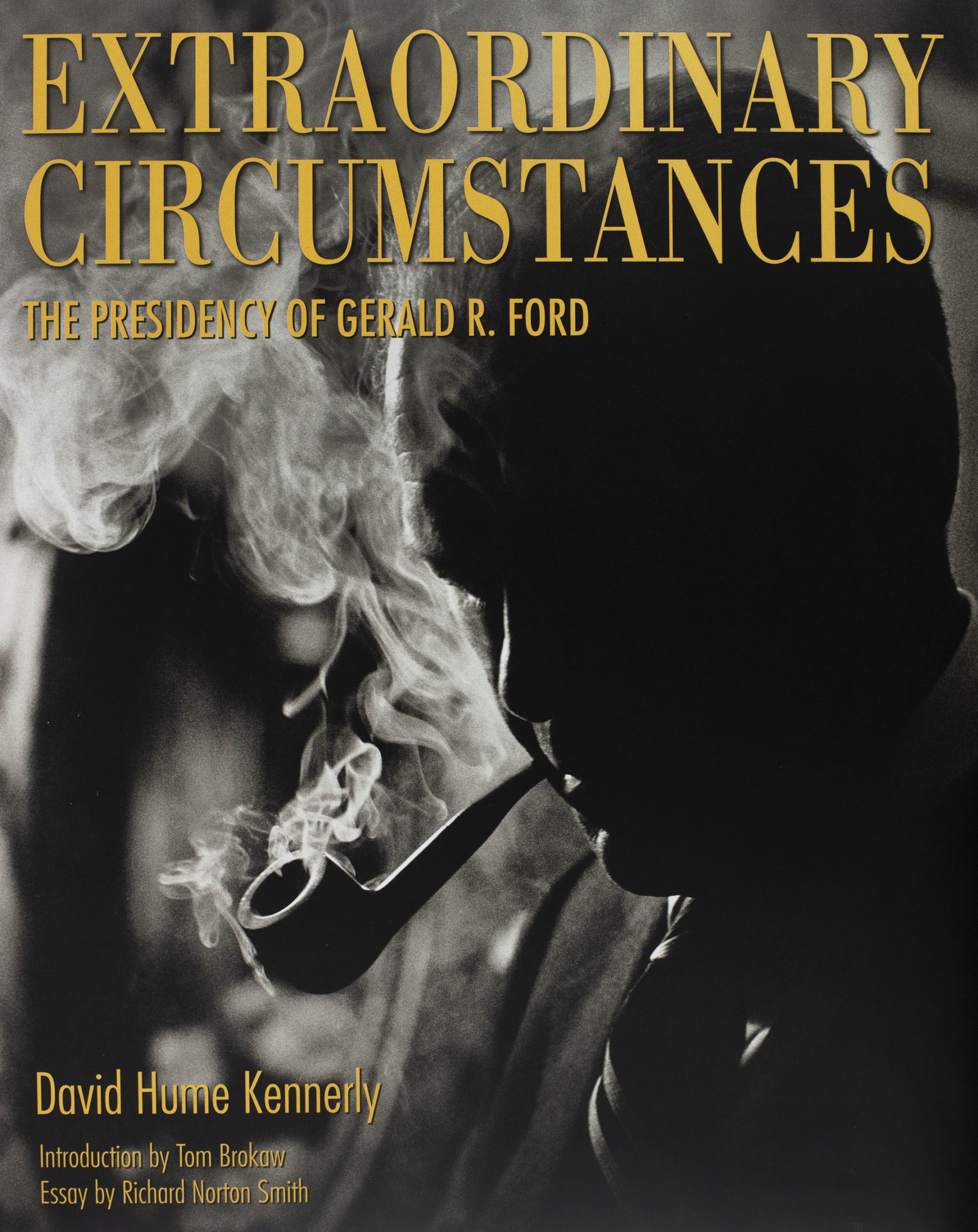
Would I like to be his personal photographer?
I told him I had misgivings and why. Then looked him right in the eye and said, “Mr. President, I would love to take the job, it would be an honor, but I have two conditions: I report directly to you AND have total access to everything going on in the White House.” (To this day I still can’t believe those words came out of my mouth). President Ford appeared slightly flummoxed and stopped smoking his pipe. I thought, “OK, I blew that one.” Then he laughed, and said, “You don’t want Air Force One on the weekends?”
Hallelujah! I hadn’t blown it.
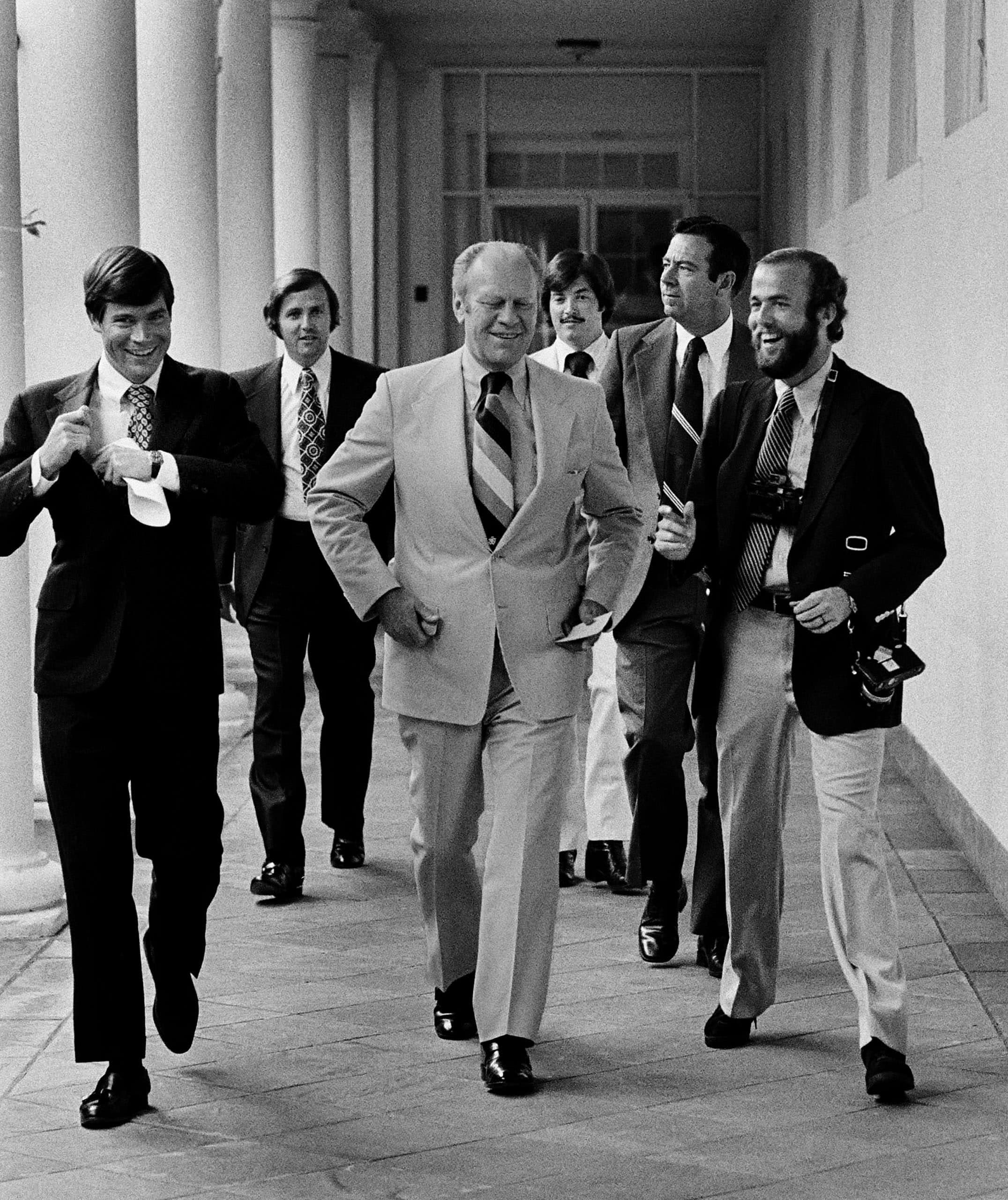
I didn’t have to call my parents to tell them that the president offered me a job but I told him to shove it. Ford understood that my wanting to always be “in the room” came from my desire to document his presidency from all angles – to create a visual record for history and that I didn’t want to miss anything.
The Ford presidency was one of my most rewarding and exciting assignments.

I faithfully, objectively, and I hope accurately, documented every moment of history that I could – and history happened 24/7 for the next two-and-a-half years. And yes, I spent hundreds of hours on Air Force One—but only when the president was on board!

Documenting history since the 60s has given me a unique perspective of our proud and imperfect nation. We are a place of heroes, villains, and those in between. But I remain an optimist.
No matter how powerful the lens, one person can’t capture it all. I believe my life's work can inspire confidence in our ability to improve as a people. It can also be a sobering reminder of how often we screw things up.
With luck my pictures will motivate a new and diverse generation (you) to be passionate chroniclers and not impartial observers (unless you’re a journalist, of course!) of our collective experience.
You can all participate in this idea. Whether you’re receiving degrees in American Indian Studies, Anthropology, Geography, History, Law, or any field, you can document your own point of view. There are social media vehicles to do that but more important, keep notes about your work and your unique perspective of the world around you. You’re seeing history every single day, so don’t let it slip away. And by all means, supplement those observations with photos!
The best line in any graduation speech is, “And in conclusion.” Here it is:
A long list of people helped and trusted me along the way. The same goes for you. Look around. You’ll see family, friends, professors, and employers. Thank them for helping you to become the person you are, and for shaping the person you will become. We are all in this together. We’re not flying solo.
Good luck and love to the 2021 graduates of The People College of the University of Arizona. You now have the Wildcat wind at your back, and an incredible journey ahead.
I’m leaving you with one of my favorite photos. I took this on assignment for Bank of America. It even went viral!

This is First Lady Michelle Obama hugging former President George W. Bush at the opening of the National Museum of African American History and Culture and personifies an optimistic note on how we can get along, no matter what gender, color, or political party. I hope it sums up how you feel today.
I love the University of Arizona’s motto: Bear Down!



